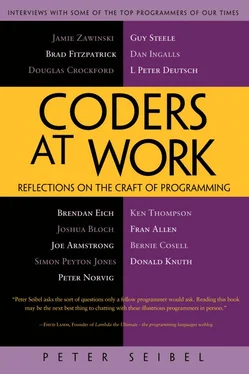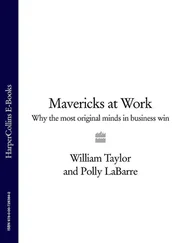Peter Seibel - Coders at Work - Reflections on the craft of programming
Здесь есть возможность читать онлайн «Peter Seibel - Coders at Work - Reflections on the craft of programming» весь текст электронной книги совершенно бесплатно (целиком полную версию без сокращений). В некоторых случаях можно слушать аудио, скачать через торрент в формате fb2 и присутствует краткое содержание. Жанр: Программирование, на английском языке. Описание произведения, (предисловие) а так же отзывы посетителей доступны на портале библиотеки ЛибКат.
- Название:Coders at Work: Reflections on the craft of programming
- Автор:
- Жанр:
- Год:неизвестен
- ISBN:нет данных
- Рейтинг книги:3 / 5. Голосов: 1
-
Избранное:Добавить в избранное
- Отзывы:
-
Ваша оценка:
- 60
- 1
- 2
- 3
- 4
- 5
Coders at Work: Reflections on the craft of programming: краткое содержание, описание и аннотация
Предлагаем к чтению аннотацию, описание, краткое содержание или предисловие (зависит от того, что написал сам автор книги «Coders at Work: Reflections on the craft of programming»). Если вы не нашли необходимую информацию о книге — напишите в комментариях, мы постараемся отыскать её.
Coders at Work
Founders at Work
Coders at Work: Reflections on the craft of programming — читать онлайн бесплатно полную книгу (весь текст) целиком
Ниже представлен текст книги, разбитый по страницам. Система сохранения места последней прочитанной страницы, позволяет с удобством читать онлайн бесплатно книгу «Coders at Work: Reflections on the craft of programming», без необходимости каждый раз заново искать на чём Вы остановились. Поставьте закладку, и сможете в любой момент перейти на страницу, на которой закончили чтение.
Интервал:
Закладка:
Seibel:If you were 13 today, would you be drawn to programming the way programming is today?
Zawinski:So hard to say. I don’t know any 13-year-olds. I don’t know what the world looks like. Things are harder to take apart now. There’s not going to be some 10-year-old who pops open his cell phone and figures out how the speaker works like I did with a phone when I was a little kid. There are no user-serviceable parts anymore.
I feel like that kind of tinkering, taking the back of the tape deck off and seeing how the gears fit together, that sort of exploration is what led to this for me. Aside from things like LEGO Mindstorms, I don’t think there’s a lot of opportunity for people to follow that path these days. But maybe I’m wrong—like I said, I don’t know any 13-year-olds. I don’t know what the toys are like. There’s a lot of video games; there’s a lot of things with remote controls. I haven’t seen any really good construction kinds of toys. Which seems sad.
Seibel:On the flip side, programming itself is much more accessible. You don’t have to master all the intricacies of assembly programming right off the bat just to make a computer do something neat.
Zawinski:Yeah. I imagine that today’s kids who are getting into programming start off building some web app or writing a Facebook plugin or something. Brad Fitzpatrick, who wrote LiveJournal, is a friend of mine. When he wrote LiveJournal he was goofing around and wrote this Perl script where he and his friends could say, “I’m going to get lunch.” The way he started out was he wrote a little Perl script and put it on a web server. Probably things will go more in that direction.
Brad Fitzpatrick
Brad Fitzpatrick is the youngest person I interviewed and the only one who has never lived in a world without the Internet or personal computers. Born in 1980, he got an early start as a programmer, learning to program at age five on a homebuilt Apple II clone. By his teenage years the Internet revolution was in full swing and he was deep into it, building his first commercial web site while still in high school and starting work on the popular community site LiveJournal the summer before he went to college.
Keeping up with LiveJournal’s ever-growing popularity forced Fitzpatrick to learn the hard way about building scalable web sites and along the way he and the programmers at the company he founded, Danga Interactive, ended up building several pieces of open source software, including memcached, Perlbal, and MogileFS, which are now used on the servers of many of the world’s busiest web sites.
Fitzpatrick is a prototypical—if exceptionally accomplished—turn-of-the-century web programmer: his primary programming languages have been Perl and C, though he also works in Java, C++, Python, JavaScript, and C# as needed. And almost all the programming he does is somehow network-related, whether it’s building better back-end infrastructure for web sites, designing protocols and software to improve the way blog-reading software knows when blogs have been updated, or programming his cell phone to automatically open his garage door when he rides up on his motorcycle.
We talked about learning to program at the same age as he was reading Clifford the Big Red Dog, why he was glad he stayed in college while running LiveJournal, and how he learned not to be afraid of reading other people’s code.
Seibel:How did you become a programmer?
Fitzpatrick:My dad was working at Mostek. They made memory and he was into computers. He built an Apple II from spare parts, pretty much. He and my mom would sit around the TV soldering it all together. It took them months, just soldering it. Then he was able to get ROMs from work that they weren’t going to sell because they had a bit, or multiple bits, stuck high or stuck low. Somehow they got the Apple II ROM and they just kept burning it onto these dead chips until they got one that worked, where the stuck bits just happened to be right. Eventually he and a bunch of his coworkers managed to make homemade Apple IIs. I was playing on that from age two or so and watching him program.
Seibel:Was he a programmer or a hardware guy?
Fitzpatrick:He was an electrical engineer; he dabbled in programming. He taught me to program when I was five and jokes that I passed him up around six or seven. My mom says I was reading the Apple II programmers’ manual from the library at the same time as Clifford the Big Red Dog . Instead of “variables,” I would say, “valuables.” Some of my first memories are programming with my dad. Like he pulled me into the kitchen and he was writing down a program on paper. He asked, “What do you think it does?” I remember it was like, “ 10 PRINT HELLO, 20 GOTO 10.”
Seibel:So you started with BASIC?
Fitzpatrick:Yeah, that was BASIC. I couldn’t do stuff with the mouse, or stuff with higher graphics modes and colors, until a friend of our family introduced me to C and gave me Turbo C. This was maybe when I was eight or ten. My dad moved to Intel in ’84 and we moved to Portland. He helped design the 386 and 486. He’s still at Intel. We always had new, fun computers.
Seibel:Did you get into assembly programming at all?
Fitzpatrick:I did assembly a little on calculators. Like Z80 on the TI calculators, but that was about it.
Seibel:Do you remember what it was that drew you to programming?
Fitzpatrick:I don’t know. It was just always fun. My mom had to cut me off and give me computer coupons to make me go outside and play with friends. My friends would come over: “Brad’s on the computer again. He’s so boring.” My mom’s like, “Go outside and play.”
Seibel:Do you remember the first interesting program that you wrote?
Fitzpatrick:We had this Epson printer and it came with big, thick manuals with a programmers’ reference at the end. So I wrote something—this was back on an Apple—where I could draw something in the high graphics mode, and then, once my program finished drawing whatever it was drawing—lines or patterns or something—I’d hit control C and be typing in the background, in a frame buffer that’s not showing, and load my other program, which read the screen off and printed it.
Before that I remember writing something that every time I hit a key, it moved the head and I had wired backspace up to go backwards so as I typed it felt like a typewriter.
This was one of my first programs—it was something like K equals grab the next char. Then I said if K equals “a”, print “a”; if K is “b”, print “b”. I pretty much did every letter, number, and some punctuation. Then at one point I was like, “Wait, I could just say, ‘Print the variable!’” and I replaced 40 lines of code with one. I was like, “Holy shit, that was awesome!” That was some major abstraction for a six-year-old.
Those are the notable early ones. Then in middle school I would make games and I would make the graphics editors and the level editors for my friends, and my friends would make the graphics into levels, and then we would sell it to our classmates. I remember having to make games that detected EGA versus VGA. If one of ’em failed on VGA, it would fault back to EGA and use a different set of tiles that fit on the screen, so we’d have to have two sets of graphics for everything. People from school would buy it for like five bucks and they would go to install it and it wouldn’t work, and their parents would call my parents and yell, “Your son stole five dollars from my kid for this crap that doesn’t work.” My mom would drive me over there and sit in the cul-de-sac while I went in and debugged it and fixed it.
Читать дальшеИнтервал:
Закладка:
Похожие книги на «Coders at Work: Reflections on the craft of programming»
Представляем Вашему вниманию похожие книги на «Coders at Work: Reflections on the craft of programming» списком для выбора. Мы отобрали схожую по названию и смыслу литературу в надежде предоставить читателям больше вариантов отыскать новые, интересные, ещё непрочитанные произведения.
Обсуждение, отзывы о книге «Coders at Work: Reflections on the craft of programming» и просто собственные мнения читателей. Оставьте ваши комментарии, напишите, что Вы думаете о произведении, его смысле или главных героях. Укажите что конкретно понравилось, а что нет, и почему Вы так считаете.












